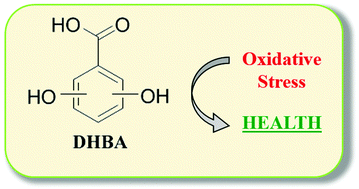Dihydroxybenzoic acids as free radical scavengers: mechanisms, kinetics, and trends in activity†
Abstract
The free radical scavenging activity of dihydroxybenzoic acids (DHBA) has been studied in non-polar and aqueous solutions, using the Density Functional Theory. It was found that the environment plays an important role in the free radical scavenging activity of DHBA. The hydrogen transfer (HT) from the phenolic OH was identified as the main mechanism of reaction in non-polar media, while the single electron transfer (SET) from the di-anions is proposed as the mechanism contributing the most to the peroxyl scavenging activity of DHBA in aqueous solution, at physiological pH. Two key structural features are associated with the reactivity of DHBA towards peroxyl radicals, via HT. The OH from which the H is transferred should be: (i) in the meta position with respect to the carboxyl group; and (ii) in the para or ortho position with respect to the other hydroxyl group. Regarding SET, the key factors are the formation of the di-anion, and its molar fraction at the anticipated pH. DHBA are predicted to be versatile scavengers in aqueous solution, capable of efficiently scavenging a wide variety of free radicals via SET. In addition, 25-DHBA, 34-DHBA and 23-DHBA were found to be among the best peroxyl radical scavengers identified so far, in aqueous solution, at physiological pH.


 Please wait while we load your content...
Please wait while we load your content...